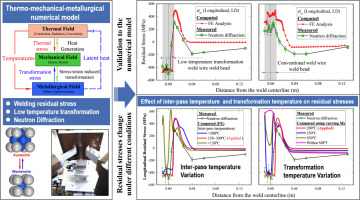当前位置:
X-MOL 学术
›
Mater. Des.
›
论文详情
Our official English website, www.x-mol.net, welcomes your
feedback! (Note: you will need to create a separate account there.)
Effects of low-temperature transformation and transformation-induced plasticity on weld residual stresses: Numerical study and neutron diffraction measurement
Materials & Design ( IF 7.6 ) Pub Date : 2018-06-01 , DOI: 10.1016/j.matdes.2018.03.032 Wenchun Jiang , Wei Chen , Wanchuck Woo , Shan-Tung Tu , Xian-Cheng Zhang , Vyacheslav Em
Materials & Design ( IF 7.6 ) Pub Date : 2018-06-01 , DOI: 10.1016/j.matdes.2018.03.032 Wenchun Jiang , Wei Chen , Wanchuck Woo , Shan-Tung Tu , Xian-Cheng Zhang , Vyacheslav Em

|
Abstract In this study, the weld residual stresses (RS) in a 25 mm thick ferrite steel plate with newly developed low-temperature transformation (LTT) welding wire were investigated by finite element method and neutron diffraction (ND) measurement. A thermo-elastic–plastic finite element model coupled with solid-state phase transformation (SSPT) was developed to investigate the distribution and formation mechanism of RS, which has been verified by ND measurement. The results demonstrate that the developed LTT alloy can significantly reduce the RS and even generate compressive RS in the weld zone, due to the interrupted cooling shrinkage caused by the LTT. The higher inter-pass temperatures related to the microstructure evolution result in an increased region of compressive stress within the weldment. Moreover, the longitudinal RS in the weld zone gradually changes to tension as the initial temperature of martensitic transformation increases. Notably, the relaxation effect of transformation-induced plasticity on RS and its influence on model accuracy were discussed.
中文翻译:

低温相变和相变诱导塑性对焊缝残余应力的影响:数值研究和中子衍射测量
摘要 在本研究中,采用有限元法和中子衍射(ND)测量方法研究了采用新开发的低温相变(LTT)焊丝的25 mm厚铁素体钢板的焊接残余应力(RS)。开发了一种结合固态相变 (SSPT) 的热弹塑性有限元模型来研究 RS 的分布和形成机制,并已通过 ND 测量进行验证。结果表明,由于LTT引起的间断冷却收缩,开发的LTT合金可以显着降低RS,甚至在焊缝区产生压缩RS。与微观结构演变相关的较高层间温度导致焊件内的压应力区域增加。而且,随着马氏体相变初始温度的升高,焊缝区的纵向RS逐渐变为拉伸。值得注意的是,讨论了转变诱导塑性对 RS 的松弛效应及其对模型精度的影响。
更新日期:2018-06-01
中文翻译:

低温相变和相变诱导塑性对焊缝残余应力的影响:数值研究和中子衍射测量
摘要 在本研究中,采用有限元法和中子衍射(ND)测量方法研究了采用新开发的低温相变(LTT)焊丝的25 mm厚铁素体钢板的焊接残余应力(RS)。开发了一种结合固态相变 (SSPT) 的热弹塑性有限元模型来研究 RS 的分布和形成机制,并已通过 ND 测量进行验证。结果表明,由于LTT引起的间断冷却收缩,开发的LTT合金可以显着降低RS,甚至在焊缝区产生压缩RS。与微观结构演变相关的较高层间温度导致焊件内的压应力区域增加。而且,随着马氏体相变初始温度的升高,焊缝区的纵向RS逐渐变为拉伸。值得注意的是,讨论了转变诱导塑性对 RS 的松弛效应及其对模型精度的影响。











































 京公网安备 11010802027423号
京公网安备 11010802027423号